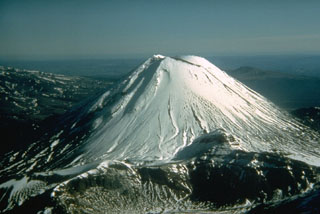Report on Tongariro (New Zealand) — 18 July-24 July 2012
Smithsonian Institution / US Geological Survey
Weekly Volcanic Activity Report, 18 July-24 July 2012
Managing Editor: Sally Sennert.
Please cite this report as:
Global Volcanism Program, 2012. Report on Tongariro (New Zealand) (Sennert, S, ed.). Weekly Volcanic Activity Report, 18 July-24 July 2012. Smithsonian Institution and US Geological Survey.
Tongariro
New Zealand
39.157°S, 175.632°E; summit elev. 1978 m
All times are local (unless otherwise noted)
A sequence of small volcanic earthquakes beneath Tongariro was detected by a few of the seismometers in the permanent network. Earthquakes with magnitudes less than 2.5 were clustered between Emerald Crater (E of the summit) and the Te Mari craters (2 km E east of Ketetahi hot springs on the N flank) at 2-7 km depth. The sequence started on 13 July, soon declined, and then again increased during 18-20 July. The Alert Level was raised to 1 (on a scale of 0-5) and the Aviation Colour Code was raised to Yellow (on a four-color scale) on 20 July.
In response to the increased seismicity, GeoNet installed four portable seismographs and conducted gas and spring sampling. During 21-22 July seismicity declined; one event was detected on 23 July. Provisional analysis of the gas samples collected during 21-22 July indicated a marked increase in the volcanic gas component of the typical mix of volcanic and hydrothermal gases. Residents reported a gas odor.
Geological Summary. Tongariro is a large volcanic massif, located immediately NE of Ruapehu volcano, that is composed of more than a dozen composite cones constructed over a period of 275,000 years. Vents along a NE-trending zone extending from Saddle Cone (below Ruapehu) to Te Maari crater (including vents at the present-day location of Ngauruhoe) were active during several hundred years around 10,000 years ago, producing the largest known eruptions at the Tongariro complex during the Holocene. North Crater stratovolcano is truncated by a broad, shallow crater filled by a solidified lava lake that is cut on the NW side by a small explosion crater. The youngest cone, Ngauruhoe, is also the highest peak.
Source: GeoNet

